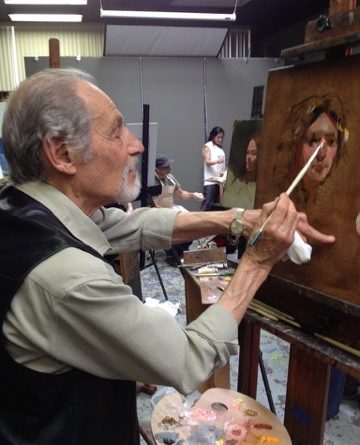Teaching Art Can Teach You to Become a Master
Listen in and review the dialogue between Sherrie and Jackie in today’s blog on how teaching art can teach you to become a master.
What Do You Learn from Teaching Art?
Jackie:
Hi, Sherrie. How are you?
Sherrie:
I’m good, Jackie, how are you doing?
Jackie:
Good. Good. Today I want to talk about your teaching career, which is a part of your life that’s really been documented a lot. You’ve touched the lives of so many students. I want to flip the cards that you play in being the teacher. I would love to talk about what you gain from teaching art? What does the teacher getting from the student?

Sherrie:
From the student? That’s a great question and it is somewhat of a cliché/ When you teach, you learn from your students. As they said – in the King and me. And it’s true. It’s true and I started learning painting when I was 20 by a couple of teachers in Oklahoma. Richard, and Edith Goetz. About a year after starting to learn from them, I needed to make some money. So, it occurred to me that maybe I would start teaching art,
What is kind of crazy, is to start teaching art only a year after you start learning. But you know, the thing that it has helped with is that in order to teach something, you have to understand it more deeply. I would say this is the most important thing that has happened.
I haven’t taught continuously since then, but you know, it’s certainly been over 40 years of teaching. I learned so much because I have to understand it better in order to explain it to a student. So, what we’ve always said is you just have to be a few steps ahead of your students. That was certainly true for me back in my twenties (when I first started).
I was a terrible teacher, very rigid. I had no idea how to teach, but you learn a lot about it, and you learn to read paintings. It’s taught me how to read and understand paintings and understand the student better by looking at their work.
Consequently, it has taught me to look at my own work to understand more about what’s going on with me. It has helped in self-discovery and certainly in my development as both a draftsman and painter. It’s been invaluable and I love it, I absolutely love it so.
But ironically, you know when I was in high school, I had an art teacher who suggested that when I went to college, that I get a teaching degree. And I remember even at the time thinking…”but why would I decide that I’ll fail before I even began?”. And that’s what it felt like. Because I didn’t want to go for a teaching degree, but I was a natural teacher. So that was an interesting thing. And I did not take her advice.

Jackie:
We’re all thankful for that.
Sherrie:
I love the Frenches.
Jackie:
Yes, yes. Tell me this, has your teaching style changed of the years?
Sherrie:
Oh, most definitely. When I began, as I said, I was more rigid in my thinking and teaching technique more. Because my first teachers were very much into teaching technique, not understanding. Then when I went to the Art Students League in New York and went into David Leffel’s class. It changed my whole understanding of what teaching could be. I went from something that was not satisfying to be honest, into something that was life changing. When I think about my role as a teacher with students, no matter whether or not they’re learning from us online or it’s actually in person.
And again, right now with COVID, that’s not happening, but that is the aspect of teaching of painting that I want to convey to a student. It is really the thing that’s motivating them. The beauty that they’re seeing in their subject is the thing that will help them learn it more quickly. If they just focus dryly on technique, then that’s what they’ll get. But if they allow themselves to be moved by the subject, try to capture the subject. Then they’re going to develop the technique, the understanding, all of that in order to capture it.
The one thing that David said early on, and it was such a powerful thing to say again as a teacher. He was the model that I learned from of how to teach. But he said that first you learn about painting and then, well you try to capture the quality in the model or the subject that you have. This is when the technique will catch up to it. So, it’s like, first you paint your your idea, This is that beauty that you’re seeing in your subject. Then your technique will follow.
And it’s such a beautiful way of seeing it, because it simplifies it. It’s the idea behind it (the way you want your canvas to look), and then all the technique and everything that you need comes into play after that.
Jackie:
Well we certainly appreciate your teaching and your ideas and philosophy, and you have gone far and wide in the world of artists. Thank you so much.
Sherrie:
My pleasure.


Leave a Reply
You must be logged in to post a comment.